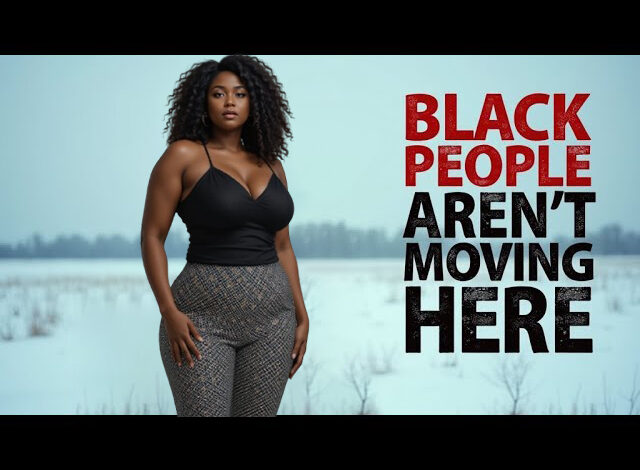
Half of America is practically vacant, and it’s not just because people suddenly lost interest in open land. Some states are so empty that you could throw a block party and still hear an echo. But the real question is: why are Black Americans avoiding them like expired milk and broken promises?
These 10 states have low population density and an even smaller Black population. But what exactly makes them unappealing? Is it the brutal winters, the eerie silence, or the bleak job market? Perhaps it’s the overwhelming feeling of “I don’t belong here.” From economic dead zones to cultural voids, let’s break down why Black Americans rarely move to these 10 states—and why some wouldn’t live there even if the rent were free.
10 States Black Americans Avoid and Why
10. Alaska – The Last Frontier or the Last Option?
Alaska is breathtaking, but it often feels more like the final boss level of Earth. With around 730,000 people spread across a landmass twice the size of Texas, it’s practically a scenic ghost town. Only 3.2% of the population is Black, making community-building almost impossible.
The biggest challenges include:
- Isolation: You could walk miles without seeing another Black person—or anyone at all.
- Brutal winters: Six months of darkness and temperatures that freeze your eyelashes.
- Accessibility: Travel costs are sky-high, and everyday goods are expensive.
- Job market: Unless you work in oil, fishing, or government, opportunities are scarce.
Alaska may be perfect for rugged adventurers and off-the-grid homesteaders, but for many Black Americans, it’s just not the vibe.
9. West Virginia – A Time Capsule with No Future
Landing in West Virginia can feel like stepping back into 1973. With a population of 1.7 million, the Black community makes up just 3.6%.
Here’s why it’s a hard pass for many:
- Struggling economy: Once a coal powerhouse, now an economic ghost town.
- Limited job opportunities: The median household income is well below the national average.
- Lack of cultural presence: No strong Black communities or institutions.
- Educational and healthcare challenges: Poor funding and limited access.
West Virginia’s scenic beauty can’t compensate for the lack of opportunity and cultural representation.
Also Read: Top 5 Richest States in America
8. Maine – The Snow and Silence State
Maine is so white that even the snow blends in. With a population of 1.3 million, only 1.7% are Black.
Challenges include:
- Cultural void: No Black churches, neighborhoods, or community centers.
- Geographic isolation: Visiting family or networking requires a long journey.
- Job market limitations: Outside of fishing and tourism, jobs are scarce.
For many Black Americans, Maine feels less like home and more like a prolonged retreat into solitude.
7. New Hampshire – The Echo Chamber
New Hampshire’s population sits at 1.4 million, with only 1.8% being Black.
Why Black Americans avoid it:
- No cultural infrastructure: No Black barbershops, restaurants, or festivals.
- Politically conservative: Socially isolating for Black professionals and families.
- Cold, rural, and uneventful: Little urban life or nightlife.
New Hampshire offers peace and quiet—but sometimes, the quiet is just too loud.
6. Idaho – The Cultural Black Hole
Idaho’s 1.9 million residents include just 1.2% Black population. The state is known for its mountains, potatoes, and, unfortunately, a lack of diversity.
Concerns include:
- No cultural representation: Few Black-owned businesses or communities.
- Conservative reputation: Often perceived as unwelcoming.
- Remote lifestyle: Limited access to major cities and job markets.
For many, Idaho feels more like witness protection than home.
5. South Dakota – The Social Desert
With a population of 920,000 and only 2.5% Black residents, South Dakota is practically a cultural desert.
Key deterrents:
- Extreme rural life: Sparse Black communities and few cultural institutions.
- Cold, conservative, and isolating: Not ideal for those seeking diversity and inclusion.
- Limited job opportunities: Few career options outside of agriculture and tourism.
For most Black Americans, South Dakota doesn’t offer enough to make the move worthwhile.
Also Read: The Richest Black Man in United States of America
4. North Dakota – The Freezer with No Flavor
North Dakota is home to just 780,000 people, and only 3% are Black.
Why it’s a no-go:
- Frigid winters: Arctic temperatures and relentless winds.
- Cultural isolation: No strong Black communities or institutions.
- Economic stagnation: Few industries outside of oil and agriculture.
Living here means battling not just the weather but also cultural invisibility.
3. Montana – A Cowboy Movie with No Cast
Montana, with 1.1 million residents, has less than 1% Black population. It’s vast, scenic, and culturally barren for Black Americans.
Biggest concerns:
- Minimal Black presence: More likely to see a grizzly than a Black-owned business.
- Harsh climate: Bitterly cold winters and limited urban development.
- Lack of cultural events: No Black neighborhoods, festivals, or community hubs.
Montana may be a dream for outdoors enthusiasts, but for those seeking connection, it’s a cultural void.
2. Wyoming – The Loneliest Place on Earth
Wyoming’s population of 580,000 includes a Black community so small it’s nearly invisible.
Why it’s unappealing:
- No Black cultural presence: No hubs, no networks, no representation.
- Extreme isolation: The least populated state with minimal diversity.
- Conservative and unwelcoming: Many Black Americans don’t feel safe or supported.
Wyoming is more suited for cowboys than communities of color.
1. Vermont – The Most White-Washed State
Vermont takes the crown as the least diverse state in America. With 640,000 people, Black residents make up just 1.4%.
Why it ranks last:
- Zero Black culture: No significant Black community, businesses, or institutions.
- Rural and isolating: Few job opportunities and long travel times to major cities.
- Cold and expensive: High cost of living with limited upward mobility.
For Black Americans looking for belonging, Vermont feels more like an exile than a home.
The Bottom Line
These states may offer affordability and natural beauty, but for Black Americans, they lack the crucial elements of community, culture, and opportunity. The desire for a sense of belonging, safety, and career growth often outweighs the appeal of scenic views and low crime rates.
Would you consider moving to one of these states, or is it a hard pass? Drop your thoughts in the comments!





